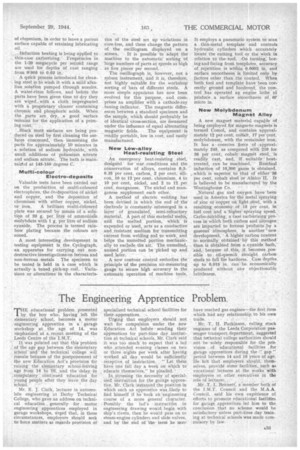The Engineering Apprentice Problem
Page 35

If you've noticed an error in this article please click here to report it so we can fix it.
THE educational problem presented by the boy who, having left the elementary school, becomes a, motor engineering apprentice in a garage workshop at the age of 14, was emphasized at a recent meeting of the Leeds Centre of the I.M.T..
It was pointed out that this problem of the age gap between the elementary school and the technical college will remain betause of the postponement of the new Education Act's provision for
• raising _ the elementary school-leaving age from 14 to 16, and the delay in ,comPulsory cOntinued education for young people after they leave .the day school.
Mr. E. J. Clark, lecturer in automobile engineering at Derby Technical College, who gave an address on technical education . generally for motor engineering apprentices employed in garage workshops, Urged that, in these circumstances, employers should seek to force matters as regards provision of specialized technical school facilities for their apprentices.
Urging that employers should not wait for compulsion under the new Education Act before sending their apprentices for part-time day instruction at technical schools, Mr. Clark said it was too much to expect that a lad who attended evening classes on two or three nights per week after having worked all day would be sufficiently receptive_ of instruction. " Let them have one full day a week on which to educate themselves," he pleaded. •
, In, Stressing the necessity of specialized instruCtion for the garage apprentice, Mr. Clark instanced the position in which such an apprentice was likely to find himself if he took an engineering . course of a more general character. Possibly the lad's instruction in engineering drawing would. begin. with ship's rivets, then he would pass on to steam-engine cylinders and slide valves, and by the end Of-the' terni he may have reached gas engines—the first item which had any relationship to his own trade.
Mr. T. H. Parkinson, rolling stock engineer of the Leeds Corporation passenger transport.department, suggested that technical college authorities should not be 'solely responsible for the provision of educational facilities for garage apprentices during the,'" gap" period between 14 and 16 years of age. He. felt that employers should, themselves, provide .some facilities,, such as vocational lectures at the works with employers or other executiVes in the role of leeturer.
Mr. T. I. Bennett, amember both of the I.M.T. Council and the M.A.A. Council, said his own expelience of efforts to promote.educational facilities for garage apprentices led him to the conclusion that no scheme would be satisfactory unless part-time day training at technical schools was made compulsory by law.




















































